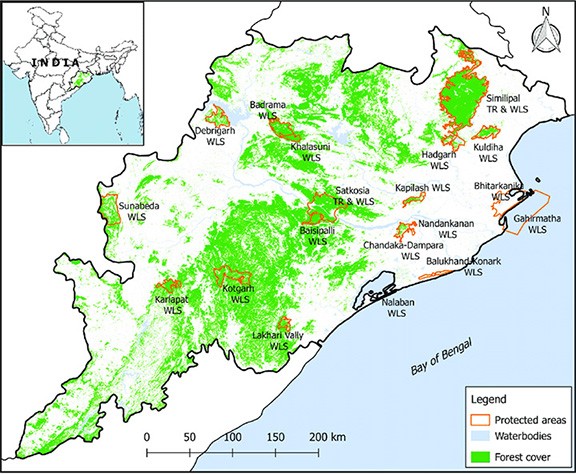Debrigarh Wildlife Sanctuary

- 10 Sep 2025
In News:
Odisha’s Debrigarh Wildlife Sanctuary has recently been approved by the National Tiger Conservation Authority (NTCA) to become India’s newest tiger reserve. This marks a significant ecological achievement rooted in community participation, innovative eco-tourism, and conservation success.
Location and Geography
- Situated in western Odisha, near Sambalpur and Bargarh district, Debrigarh is bordered by the Hirakud Reservoir—a Ramsar-tagged wetland and part of the Mahanadi River system.
- The Hirakud Dam, the world’s longest earthen dam, lies adjacent to the sanctuary.
- Spread over 804 sq km, it includes around 347 sq km of core area, encompassing forests, grasslands, and wetlands, making it a unique amphi-terrestrial ecosystem.
Historical Significance
- The rugged terrain of Debrigarh was a strategic base for freedom fighter Veer Surendra Sai during his armed resistance against British colonial rule.
- Sites like Bara Bakra/Barapathara remain important heritage landmarks within the sanctuary.
Flora and Fauna
- Vegetation: Dominated by mixed and dry deciduous forests, with species such as Sal, Asana, Bija, Aanla, and Dhaura.
- Mammals: Indian bison (gaur), sambar deer, wild boar, chousingha (four-horned antelope), leopards, sloth bears, and wild dogs.
- Avifauna: Over 300 bird species, including 120 migratory species such as crested serpent eagle, drongo, tree pie, flower peckers, and white-eye oriental.
Eco-Tourism and Innovation
- Debrigarh is home to India’s first dark sky tourism hub, offering stargazing facilities.
- Adventure tourism includes safaris (53 vehicles), kayaking, cycling, and birding trails, designed with minimal ecological footprint.
Conservation and Community Model
- Declared a sanctuary in 1985 and upgraded to a tiger reserve in 2025.
- A community-led model: Over 400 families voluntarily relocated with rehabilitation packages; 155 villages actively participate in conservation and eco-tourism activities.
- Wildlife success: Expansion of prey base, increase in gaur population, and nearly 40% of herds comprising newborns, reflecting ecosystem recovery.
Significance
Debrigarh exemplifies a national model of integrated conservation, blending:
- Biodiversity protection (tiger reserve status, prey base recovery).
- Cultural heritage (legacy of Veer Surendra Sai).
- Sustainable eco-tourism (dark sky hub, water- and land-based safaris).
- Community participation (relocation and livelihood integration).
Its success offers a replicable blueprint for wildlife conservation across India, highlighting how ecological protection, heritage, and rural livelihoods can be balanced under one framework.
